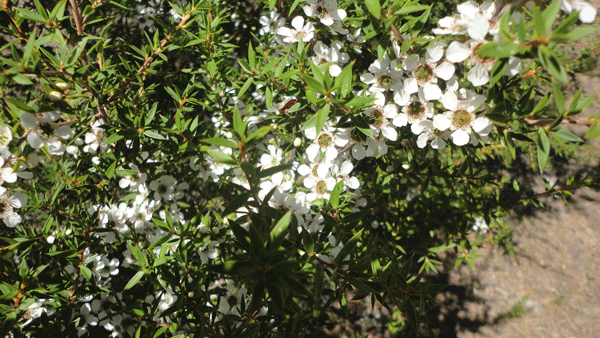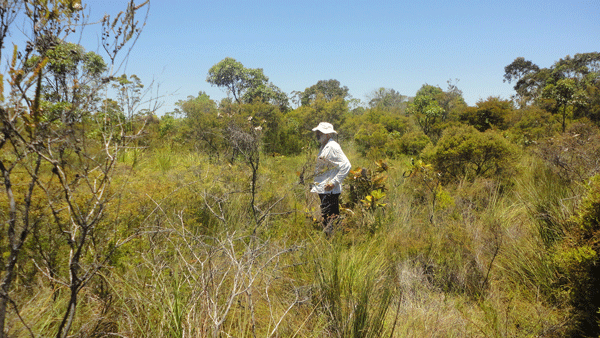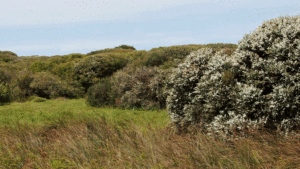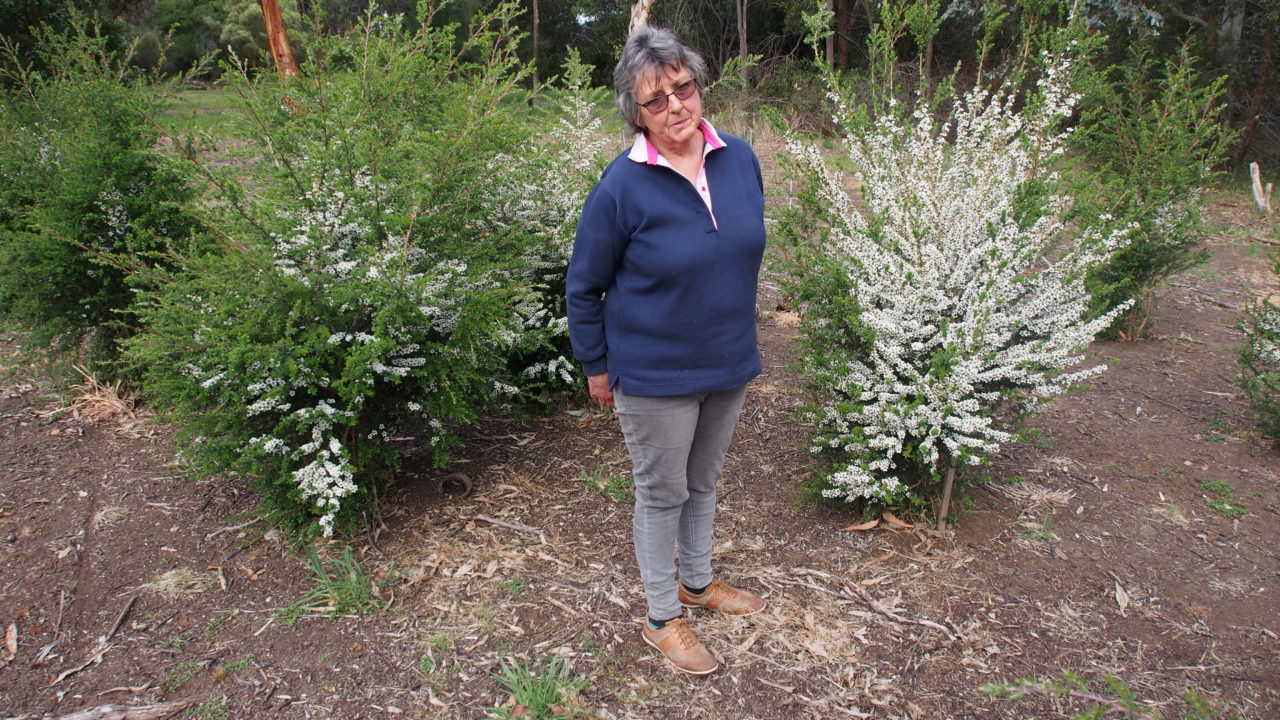
Selecting a species involves a much wider set of considerations other than DHA levels. The manuka industry in New Zealand based on Leptospermum scoparium which has on average many times lower DHA levels (2,000 to 3,000 ppm) than some of the Australian Leptospermum species.
Plant breeding and selection has increased these levels significantly in New Zealand manuka.
Wild populations of Australian species such as L. whitei and L. speciosum are reported at being around 15,000 ppm with L. polygalifolium coming in at variously 8,000 ppm for Broadwater and 10,000 ppm on the Sunshine Coast. These values are regarded as indicators and will be refined with more detailed and systematic testing over time.
Simon Williams, a then PhD student from the University of the Sunshine Coast, recently reported that he has now tested 35 of the Australian Leptospermum species but is quick to point out that some of the values obtained were on the basis of as few as one sample. It is quite an achievement over such a short period of time and sets out some direction in which this should be heading for further testing and evaluation. As expected many of the species tested did not have any bio-activity so it must be assumed that all Leptospermums are active.
It is not a good idea to solely consider the potency of the species at the expense of the other selection criteria when deciding on a species for a plantation.
- By far the most important selection criteria is the capacity for adaptability in cultivation, It seems logical and indeed true that the species with the widest natural range must also have the highest adaptability because it has adapted to a range of different soils, seasonal rainfall, maritime influences, extreme cold and extreme heat. Species meeting this essential criteria will also adapt well to cultivation in a managed plantation setting.
- The species must have good form, a dense habit and grow to a mature height of 2 to 4 metres so that the considerable above ground biomass will produce an abundance of flowers.
There are two species that fit those criteria now with a few more that show great promise. These species are of course manuka (Leptospermum scoparium) and jelly bush (Leptospermum polygalifolium). It is these two that I will focus on for the time being. Having said that, Leptospermum continentale and Leptospermum lanigerum show significant promise and more focussed sampling and testing will be undertaken from 2018.
Species indicating very high DHA levels include Leptospermum whitei and Leptospermum liversidgeii both of which occur naturally around SE Queensland to Hervey Bay and the NSW North Coast and south to Coffs Harbour, in infertile wet coastal heathlands always with their roots in water and always very humid in Summer particularly.
Selecting a species involves a much more comprehensive set of considerations other than DHA levels. The manuka industry in New Zealand based on Leptospermum scoparium which has on average many times lower DHA levels (2,000 to 3,000 ppm) than some of the Australian Leptospermum species.
Plant breeding and selection has increased these levels significantly in New Zealand manuka.
Wild populations of Australian species such as L. whitei and L. speciosum are reported as being around 15,000 ppm with L. polygalifolium coming in at variously 8,000 ppm for Broadwater and 10,000 ppm on the Sunshine Coast. These values are regarded as indicators and will be refined with more detailed and systematic testing over time.
Simon Williams, a then PhD student from the University of the Sunshine Coast, reported in 2017 that he has now tested 35 of the Australian Leptospermum species but is quick to point out that some of the values obtained were from as few as one sample. It is quite an achievement over such a short period of time and sets out some direction in which this should be heading for further testing and evaluation. As expected many of the species tested did not have any bio-activity so it must be assumed that all Leptospermums are active.
It is not a good idea to solely consider the potency of the species at the expense of the other selection criteria when deciding on a species for a plantation.
By far the most important selection criteria is the capacity for adaptability in cultivation, It seems logical and indeed correct that the species with the most extensive natural range must also have the highest versatility because it has adapted to a variety of different soils, seasonal rainfall, maritime influences, extreme cold and extreme heat. Species meeting this essential criteria will also adapt well to cultivation in a managed plantation setting.
The species must have good form, a dense habit and grow to a mature height of 2 to 4 metres so that the considerable aboveground biomass will produce an abundance of flowers.
Two species fit those criteria now with a few more that show great promise. These species are of course manuka (Leptospermum scoparium) and jelly bush (Leptospermum polygalifolium). It is these two that I will mainly focus on for the time being. Having said that, Leptospermum continentale and Leptospermum lanigerum show significant potential. A more focused sampling and the testing regime will be undertaken from 2018.
Species indicating very high DHA levels include Leptospermum whitei and Leptospermum liversidgeii both of which occur naturally around SE Queensland to Hervey Bay and the NSW North Coast and south to Coffs Harbour, in infertile wet coastal heathlands always with their roots in water and still very humid particularly in Summer.

Leptospermum whitei and Leptospermum liversdidgeii growing together in sub-coastal infertile swampy heathland in the Sunshine Coast near hinterland.
I grew 20k L. liversidgeii tube stock in 2015 – 16 in Western Victoria. All went well until the first significant heatwave. Despite keeping them wet, they all died on the first day it reached 40 degrees due to the extreme heat, low humidity and solar radiation.
Southern species that have been tested with quite significant DHA levels including Leptospermum continentale amongst others. This is a close relative of Leptospermum scoparium, very tough and adaptable but can have inferior form, spindly and may not have the mass to produce abundant flowering when grown in marginal areas. Leptospermum lanigerum is a great plant and ticks most of the boxes but always grows in swampy areas and in creeks even in high rainfall areas but will not survive prolonged dry conditions.
Leptospermum polygalifolium has a widespread natural habitat ranging from the highlands of Southern NSW close to the Victorian border right up to the dry western side of the Atherton Tableland near Herberton QLD. From coastal areas south of Batemans Bay to just north of Cooktown in FNQ.
This species has been divided into 5 sub-species;
- Leptospermum polygalifolium subsp. polygalifolium (mainly sea level from South of Sydney to the Victorian Border and at altitude to areas like Braidwood and Bombala)
- Leptospermum polygalifolium subsp. cismontanum (primarily coastal areas from north of Sydney to Hervey Bay QLD)
- Leptospermum polygalifolium subsp. montanum (from the coastal strip up to the eastern side of the Great Dividing Range)
- Leptospermum polygalifolium subsp. transmontanum (occurs on the western side of the Great Dividing Range in North Central NSW extending well into QLD and out into the drier country where it may be found along seasonal waterways and drainage lines)
- Leptospermum polygalifolium subsp. tropicum (from the central coast extending up in FNQ both coastal and inland)
- There is a 6th subspecies (Leptospermum polygalifolium subsp howensii) restricted to Lord Howe Island. As exciting as this may seem it is believed that for some reason this subspecies is inactive.
The mainland subspecies while displaying subtle botanical differences when compared to each other they are all considered to be bio-active, but the extent of that bio-activity between subspecies is yet to be tested and maybe also be affected by variable soil conditions, climate etc. Trials of the various subspecies need to be compared in a plantation setting where all those variables are the same.
The use of the above nomenclature is convenient as a guide to determining suitability when the plants are put into cultivation (e.g. cold, coastal, tropical, drought tolerance etc.)

Leptospermum polygalifolium subsp. polygalifolium growing along a roadside at near sea-level south of Batemans Bay NSW. This is towards the southern end of its natural range.

Remnant Leptospermum polygalifolium subsp. tropicum along a seasonally dry creek bed 20km west of Herberton QLD. This is the northern end of its natural range.

Leptospermum polygalifolium subsp. transmontanum growing along a roadside west of Stanthorpe near the QLD NSW border

Sampling nectar in SEQ from roadside communities of Leptospermum polygalifolium.

SEQ. Leptospermum polygalifolium nearing the end of its flowering period. Can you spot the green tree frog ?
There is plenty of scope with this resource to match the species to the application. Contrary to some popular misconceptions this species will adapt very well to other areas in Australia. Trials and some small-scale operational projects are currently underway in some irrigation areas in NSW and South Australia Southern Victoria and in the SE of South Australia, the Mt Lofty Ranges and Kangaroo Island.
Leptospermum scoparium occurs throughout southern and eastern Victoria extending into far southern NSW and is found throughout Tasmania.
This species is highly adaptable and will grow just about anywhere on the coast or in an inland site provided it has some soil moisture.
When in cultivation this species will grow into a well-rounded uniform attractive-looking shrub.
Both species are very forgiving and will grow on poor soils again provided soil moisture is available.

Leptospermum scoparium growing in Western Victoria where it is the furthermost western occurence of the species. These plants have colonised a scraped area below a large dam. Individual plants such as this when given enough space to develop into well-shaped specimens confirming that this species is an ideal plantation choice.
The dam leaks in winter and may dry out in Summer meaning that these plants are waterlogged for at least half the year and when this soil dries out it sets like concrete. Not much else will grow here, but these are thriving. Temperatures in summer can regularly reach over 40c in this area.

Leptospermum scoparium growing in coastal seasonally wet heathland in Southern Victoria <1 km from the sea. Note the specimen in the foreground is in full flower while the specimen in the background is yet to flower.
The variation in flowering time between individuals within the same population appears to be a characteristic common to other Leptospermum species as well and a very desirable trait when considering these plants in a plantation context.
Another early observation is that the inland population of this species flowered in December-January last year (2014-15) in what was a very dry year in a succession of dry years. It looks almost certain that these plants will again flower at the same time (December to January) in 2016-17 which indicates that prevailing climate and rainfall is not determining the time at which they bloom.
Travel some 100+ kilometres to the coast and the same species flowered in September to mainly October in 2015 and the same time in 2016 and again went from very dry to very wet in the two consecutive years.
Trials are underway to confirm whether this is something genetic or whether it is a climatic/environmental effect. If it turns out to be genetic, then the implications for extending the overall flowering period in a plantation setting are clearly quite profound.
(Move to February 2018)
The spring-summer period of 2017-2018 has clearly demonstrated beyond doubt that the extensively tested inland provenances (I use) flower in (and close to) January and the coastal provenances in (and close to) October in any given year.
I am of the view that it would take a massive climatic or seasonal weather impact to shift this anywhere. Severe drought (without irrigation) may severely affect the flower volume and nectar flow but not necessarily the time of flowering to any significant degree.
In the plantation context, it is now quite easy to double the total flowering period by merely planting selected inland and coastal provenances of the species.

Other Species Deserving Attention
